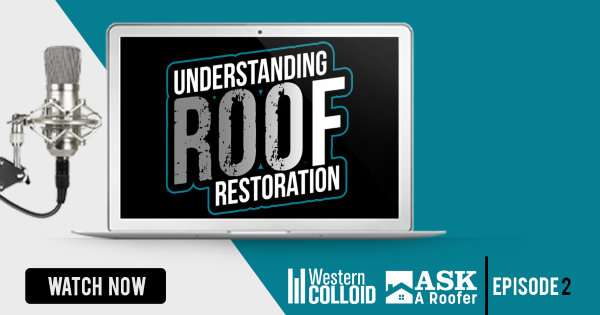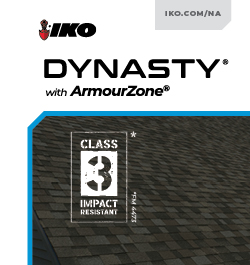Rooftop Retreats Done Right - PODCAST TRANSCRIPT
June 24, 2025 at 9:00 a.m.Editor's note: The following is the transcript of a live interview with Al Torrella of Elite Roofing. You can read the interview below or listen to the podcast.
Intro: Welcome to the AskARoofer Podcast, where all your roofing questions find their answers. Your hosts, Megan Ellsworth and Lauren White, peel back the layers of the roofing world to reveal the knowledge, tips and FAQs you've been curious about. From shingles to skylights, metal to asphalt, we are here to demystify the system above your head. So get ready to ask, learn and explore the fascinating world of roofing one question at a time on the AskARoofer Podcast.
Lauren White: Hello, everyone, this is Lauren White with the AskARoofer Podcast and we are joined today with Al Torrella and we are so excited to talk about our rooftop retreats done right. And, Al, I'll have you introduce yourself.
Al Torrella: Hi, my name is Al Torrella. I'm the owner and operator of Elite Roofing in Bayonne, New Jersey in the Hudson County area here and I've been doing this job since 1983. Long time.
Lauren White: And a lot of knowledge.
Al Torrella: A lot of water under that bridge. Oh yeah.
Lauren White: Well, we are excited to have you on the podcast today and we are going to be talking about designing the perfect roof patio. So can you explain to us what a roof patio is and why it's becoming a more popular feature in homes?
Al Torrella: So usually the rooftop patio system is more for a urban environment, cityscape more or less, where all the houses are top of each other, where you have very little space in your backyard. People want to go out and have a hot dog or a hamburger or just smell the air and not be with other people but your family. So the only alternative left is their roof, believe it or not and the roof actually has the best views of the whole area. So people usually want to do that. And then if you can have some fun up there and you have your family, you have your little cookout and it's a great area when you want to get away from being in the house without leaving your house.
Lauren White: Yeah.
Al Torrella: That's kind of it.
Lauren White: Very true.
Al Torrella: Yeah.
Lauren White: Yeah, nice view. Get some fresh air and enjoy a different aspect of your home.
Al Torrella: Yeah, yeah, yeah. Well, how do you design a rooftop? I think that's one of the questions I would think would be. But we have to step back back from that. I'll give you an analogy. When my house burnt down from a fire several years ago and I rebuilt my house, I rebuilt it with being there every day and doing everything every day and just doing all hands on with the contract and stuff like that. And then after the house was built, the obvious thing is you furnish the house, but when you furnish the house, you don't really know what kind of furniture you're really going to put in the house. And that made it awkward because you wanted something and you designed a room, it didn't fit in there. So I really think that designing a perfect rooftop, you want to know how you want to live first.
Do you want a garden scene or do you want a wrap-around couch or you want a bar system? So I would pick out the stuff that you really want first and take little cutouts or a piece of paper and the little cutouts to match it and then place them. So you could design your own little rooftop first before you can waste any kind of money. It'd be the easiest, fastest and they have programs to do all that nowadays and they have video games to do it and stuff like that. All kinds of ways you could do that. But that would be the most way I would think to actually plan out your rooftop is to pick out what kind of furniture you want to put on your rooftop and design around that.
Lauren White: Yeah, absolutely. No, that's a great point that people probably don't think of. They're just, "I just want it to happen."
Al Torrella: They just start building and then they try to fit furniture to match the rooftop, which doesn't really work.
Lauren White: Right. So what are maybe some of the other considerations that people should think of first when planning for a new roof patio?
Al Torrella: Well, truthfully, in the city area, you really got to have an architect to make sure that the roof can hold your rooftop because you don't want to be building something where it's going to collapse on you and stuff like that or it's not up to code and if you ever sell your house and you're trying to sell it and somebody finds out you didn't get the proper permits and stuff like that, then you're not really selling your house are, you're kind of getting smooth. But you really want to make sure you start with hiring a professional architect and making sure that you can put something up there that's going to be stable first. That's square one.
After square one, after doing that, then you got to hire a contract or somebody that's really... You want somebody who's done rooftops before, knows the problems, the ins and outs of it and stuff like that and you get a good handle and see what kind of work they are and then just go online. I say go online and look at pictures. You know what your heart likes already Everybody knows what they like. You see a picture and you try to replicate that, you try to design around that. But that's how I would do it if I was doing something like that. The first thing I would do is hire an architect. We could put up there. Then look if the furniture will fit in. Oh, wait.
The mailman. The mailman. Okay. So, that's how I would. Design furniture. Hire an architect, get a GC. Then you submit your permits and obviously which city you're in building is another problem. It depends on what state you're in. New Jersey has this law where if you have a roof, you could only put 50% of the roof toward the rooftop deck. The other 50% is green roofing, which is those little green plants or grass and stuff like that. If you don't put the green, then you're only allowed to put 30%. But then I've been on jobs where people have the whole entire roof completely a roof deck, which is totally against code, but somehow, somewhere they got it approved. Makes no sense to me whatsoever how that whole process is done. But I just try to... With the architect and the builder and stuff like that, I've been doing a couple of them and I just finished one where we ...
Will you stop? Go sit down. Well, we just finished one. Everything was done perfectly and it was getting approved with the approval process from the permitting and the guy comes with this code where now you've got to have two means of egress from the rooftop deck.
Lauren White: Wow.
Al Torrella: So it was in the permit stage, the planning stage for over a year. And now after all the work is done, two years later, the inspector is saying, "Oh, we can't pass this. You need two ways of getting off the rooftop deck." "Where were you two years ago to say this?" It baffles what the little pitfalls are, but then the architect cited some kind of code or something like that. I don't know. Maybe they didn't like the guy building [inaudible 00:08:19] who knows the reason, but the architect came in with some kind of code and they passed it. But those things happen. You never know what's really going to happen. You could plan and plan and plan and then out of left fields I'm getting [inaudible 00:08:35] Soph, call him back, please.
Speaker 4: Yes.
Al Torrella: I'm so sorry.
Lauren White: That's okay. All good.
Al Torrella: Yeah, so things happen. You never know what's really going to happen, but I love doing rooftop decks because you feel free when you're on top of the roof. It's like you're on top of your building, you're on top of the world, everything's okay no matter what it is. And you are out there enjoying a soda or having a hot dog. It's really living life. I think it's even better than the backyard because the backyard, you're on the ground with the mosquitoes. On the roof, you get that nice breeze, you get the good views, it's better. I think it's actually better living, stuff like that. Better than a balcony. Rooftop, can be 300, 400 square feet. I've seen them 500, 600, 700, 800 square feet, even bigger than that. But again, the bigger they are, the more money it cost [inaudible 00:09:39]. Yeah
Lauren White: Yeah. What do you think are maybe some of the common misconceptions homeowners have about building a roof patio?
Al Torrella: What do you mean misconceptions? Why they can't do them? Or what do you mean by that? Just clarify?
Lauren White: Or maybe just things that people don't think about. The hiring an architect or maybe, "Can't I just put something on my roof?" Are there any other-
Al Torrella: Oh, yeah. People think-
Lauren White: ... maybe that you know of misconceptions?
Al Torrella: People think they could put anything... I was in another building about three weeks ago. It was a co-op, a condo building and on the roof they just put some pallets on the roof. They were pallets on the roof and his plant is on top of the pallets. And then they were calling me, "Why is the roof leaking?" Well, I didn't do the roof first of all, so I said to them, "Maybe because you put pallets on the roof to walk around on pallets. Because now the pallets, there's no drainage mat. You got pallets on the roof, you're walking on them. The wood is not designed to be up there. So you have splinters and it's raining and when you're walking you're making holes in the roof and stuff like that." Besides, there was nails and they just totally did it themselves. They were just trying to figure out why they were leaking and stuff like that.
So people do things. It amazes me what some people try to do and it baffles me that people can do things like that without actually not even hiring a professional in the first place. They didn't want to pay for the roof deck so they just put pallets up there and then they were why everything was leaking.
Lauren White: There's a process for a reason.
Al Torrella: And then the manufacturers don't want to honor their warranty, water leaking.
Lauren White: Right.
Al Torrella: Well obviously, because you shouldn't have been doing that in the first place.
Lauren White: Yeah. Roof patio is probably not something anyone should be DIYing. You want to bring in the professionals.
Al Torrella: Yeah. And another thing is when you're doing a rooftop deck, you always want to make sure that you put a new roof on before you do that, because 10 years goes by like that. And most roofing systems are 10 years. They say they're 20-year warranties, but more or less they're 10 years. You get 20 years if you do maintenance on the roof and stuff like that. Most roofing systems are 20 years, like EBDM, TPO, but you got to make sure that's maintenanced. It's not going to last 20 years. So you got to make sure that stuff is maintenanced. You want to make sure your roof is actually a brand new roof before you do anything. And then you actually want to beef that up so it can actually last longer than 20 years because you don't want to be ripping off, taking it apart, your deck because your roof's leaking.
But then I have people that I tell them, "Instead of building a rooftop deck with tracks or something like that, which [inaudible 00:12:44] looks nice, tracks is gorgeous and stuff like that. You could actually just put a drainage mat on top of your existing roof and then you put those little tiles. So where are those little tiles? Those little exact blocks?
Speaker 4: Oh.
Al Torrella: Yeah. Hang on for me. Let me show them. This is so cute. Anytime today, kid. Okay, I don't know if you guys can... Can you see this?
Lauren White: Yeah, kind of.
Speaker 4: No, it's kind of blocked out by your face.
Al Torrella: We'll fix that.
Lauren White: Oh, there we go. Yeah, I saw it.
Al Torrella: Wait, why is it not-
Lauren White: Got to get the angle just right.
Speaker 4: Yeah.
Lauren White: There you go.
Al Torrella: You see? And you see the bottom? Can you see them?
Lauren White: Yeah.
Speaker 4: You have that thing on the background.
Al Torrella: You see the bottom of it? Let me turn it around.
Lauren White: I did see it. Yeah,
Al Torrella: You see the bottom of it?
Lauren White: Yeah.
Al Torrella: Okay. So it's in a grid. A grid. And it can hold actually four eight by eight blocks. Okay. So you put a drainage mat down first because when it rains, you want it to go through the pavers to a drainage mat, which runs the water underneath because you don't want to put it right on top of the roof because then if you put dirt on it gets clogged and you'll have problems. You want to put a drainage mat and then put that. But then if you put that, if there's a problem, you can always take it off and fix the roof, minimum cost, which is actually, they're very nice and it's the cheapest, economical way of doing it. And if there's a problem with your roof, you have to do maintenance. You just pick them up and you just do what you got to do and you put them right back-
Lauren White: That's convenient.
Al Torrella: ... which is very convenient.
Lauren White: Yeah.
Al Torrella: Or you can go high end and then build your frame and do your tracks and do your other stuff, but then if you've got problems, you got to take that all apart.
Lauren White: Right.
Al Torrella: Yeah.
Lauren White: Right.
Al Torrella: So you really got to consider which way you really want to go.
Lauren White: Yeah, absolutely. So since we're talking materials, what are some of the materials that work best for these roof patios? You've mentioned tracks and then those tiles that you just showed. Are there any other ones?
Al Torrella: Those are the Azek tiles. They're not Azek no more. They're called Aspire now. Aspire bought them out. But they were the Azek tiles. They're very nice and they come in four by four, four by eight or eight by eight and different colors. And you can make patterns like you do a regular paver system, which is nice. On the ground, you could do your paver system. This is nice because you don't need no stupid sand. Like in your regular pavers on the ground in your driveway or on the street, you have to put sand in between them. These you don't put no sand and they always look nice. There's no weeds growing between them, which is, oh, I love that one. No weeds growing out your pavers.
Lauren White: Yeah.
Al Torrella: So I use those. Then they have those little rubber mats. You've seen them, they're two by two and they're interlocking. Those are the older way. We used to use those. And then you got tracks. You build your frame with your pressure treated wood or... So let me see this. This little box right here. This little box right here?
Al Torrella: It's a metal steel rail or lightweight aluminum on a pedestal. Okay. So the old days they had the icing PVC inside this instead of like this. You know PVC, like the stuff for the drains, they have the first way and then they would cut them the size and stuff like that. This has got the height difference pedestal and you put them on top and then you can put your tracks on top of this now.
Lauren White: Okay.
Al Torrella: This is very nice. This is from Europe and stuff like that. So it's very lightweight. It's expensive, but it's very lightweight. This is [inaudible 00:17:12] but it's lightweight. You can put your tracks to this. You can have your frames and all your other stuff, your rail and stuff like that. This is the future of the decking system. The other way is the regularly old way, which is the wood where you build it in wood, pressure-treated wood, but you got to build your frame to your knee walls and you build your frame and then you put your tracks on top and then you use your invisible screws where they hold the block down together and you screw it down together and it holds everything out. This is the newer way, which I think is going to take off. It just needs the right introduction, stuff like that, without obviously the price.
The price is always a factor, but you could do more with this than the old way and it's a lot less weight, which is a big factor you're talking about. How much weight can you put on the roof deck and stuff like that.
Lauren White: Right. Yeah.
Al Torrella: So that's the future right there. The very thin metal rails, you could buy them and then you could put your tracks to that or wood to that or whatever. But if you're going to spend the money on that, the metal railing system, then you have money to put tracks. I think what's tracks is like for every 16 foot, it's like $69 right now or $70 a board. So every, was it five and a half inches by 16 feet? $70. So how much is that in dollars, I guess, per square? I'm thinking maybe it's like, I would say about a $1.80 a square foot, a $1.90 a square foot just to buy the material.
Lauren White: Yeah. Yeah. Interesting. So what other maybe innovations or trends are you seeing in the world of roof patios? You just shared one. Are there any others that you're seeing?
Al Torrella: Let me see. So I've seen the pavers, I've seen the rubber blocks that they use in the playgrounds. Astroturf is actually very nice, believe it or not. There's different styles of astroturf, believe it or not now. Not like one side fits all. There's putting greens, which is the real small and then you got the stuff for the dog lovers. If you have a big... Obviously you saw my dog. I am a puppy doggy person.
Lauren White: Me too.
Al Torrella: Well, that's the one. Where's the other one? There's the other one.
Lauren White: Okay.
Al Torrella: Yeah. So you got to have, again, you need a drainage mat. Do not put this right to your roof. You need to have a drainage mat. Very, very, very important because obviously when the water gets here, it goes through here and it comes through the holes at the back. You want it to drain to a drainage mat. And a drainage mat's about half inch, three quarters of an inch. And that takes all your water to your drain. You don't want to obstruct your drainage because you start obstructing your drainage, you could pop your seams in your roof when it builds up on it. You don't want it to do that.
This is actually good if you have a dog. And so if you have a truck stack... There was one customer that has a deck up the roof and I was telling them... They wanted to have a dog. They want to put this down too so the dog can run and then do his business. He feels like he's the street and stuff like him, but he's on your deck and stuff like that. If you have a little dork and it's on your deck, you have to worry about the scupper box holes, you know the drainage holes. You have the retaining walls as a little... You don't want the dog to go through the hole and then fall off the roof. That'll be bad.
Lauren White: That'd be bad. Yeah.
Al Torrella: So you got to cover that and stuff like that. And then you put this on and this is green all year long.
Lauren White: Yeah, there you go.
Al Torrella: This is nice. This is nice. And this is not from Home Depot. This is not the Home Depot. And I have nothing bad about Home Depot. I love Home Depot, but we all know that there's better material out there if you go from the manufacturer. There's a lot of stuff that's better. Stuff like that. So whatever you can imagine we could do. It all depends on what you can imagine. That's why, when I do commercials and stuff like that, your deck is like your dream. You could dream big and we could do it. Whatever you want. But starting somewhere. I think starting is seeing how you want to live, how you want to be up there. Do you want to be on a couch? Do you want to be watching your TV up there? Get a SunBriteTV.
Lauren White: Yeah.
Al Torrella: Now they got Vudu. You could just do it right up on the... You bring everything right to your smart screen on your roof.
Lauren White: Yeah.
Al Torrella: Just make sure your TV's waterproof and stuff like that. That's why you need a smart screen. But, yeah.
Lauren White: Yeah. And so I mean, I feel like roof patios are probably better in certain areas, in certain climates than others. So how do climate and weather conditions influence a design or even the material choices? What should people think about?
Al Torrella: You mean compared to, I guess, if we were in Florida compared to if we lived in New York?
Lauren White: I'm in Oregon, so maybe Florida and Oregon.
Al Torrella: It's the north-west of the country.
Lauren White: Yeah.
Al Torrella: You got Washington, then you got Oregon, then you got California. Is that right?
Lauren White: Correct.
Al Torrella: Okay, so you're cold, but you're not very, very cold and you're a lot of rain on you. Right? You got a lot of rain.
Lauren White: Rain and snow. Yeah.
Al Torrella: Out of the whole year, how much snow do you think? How much cold that you can't go outside? How many months a year do you think you got out there?
Lauren White: Not being able to go outside?
Al Torrella: Yeah, really cold.
Lauren White: It doesn't get that cold.
Al Torrella: Yeah.
Lauren White: I mean, maybe two?
Al Torrella: Three months, four months?
Lauren White: Two to three.
Al Torrella: Two months? Three months?
Lauren White: Yeah.
Al Torrella: Snow.
Lauren White: Yeah.
Al Torrella: Then the other six months is intermediate, I guess.
Lauren White: Yeah, rainy, chilly.
Al Torrella: 50 to 70. And then the other ones are-
Lauren White: Sometimes 40s.
Al Torrella: ... 80 to 100. You got a three months, right?
Lauren White: Yeah.
Al Torrella: So, I guess, do you want to be out there in the cold? If you want to be out there in the cold, you buy one of those heater things out there, you know those little bar heaters and stuff like that or you put the propane tank in.
Lauren White: Yeah.
Al Torrella: Why not? You could smoke your cigarette, put your little bar heater on, have a glass of champagne or a glass of bubbly and yeah. I've done a lot.
Lauren White: From context to design, right?
Al Torrella: Yeah.
Lauren White: What your wants are.
Al Torrella: I was watching this movie the other night. I guess it's a trend right now. I guess it's The Last of Us, from HBO and I was watching. It was Pedro and he was talking, he was out there... I guess the movie is shot in Wyoming or something like that. It was supposed to be in Wyoming. He's out on his porch. It was New Year's Eve and he's on his porch with his guitar and he had this little space heater in front of him. And I was laughing him. I'm like, "This guy's got this little space heater in front of him. It's the middle of winter time time. He's in Wyoming, but he's out there with his guitar." Okay. I thought that was great. I love that scene right there. That was the best because you love the outdoors. You're on your porch. Okay, you're not on your rooftop deck, but what the hell? You got your little space heater in front of you.
Lauren White: There you go.
Al Torrella: Sure. Why not?
Lauren White: Nice and warm.
Al Torrella: Yeah, exactly. Nice and warm. But then I guess you have those people, if you want it, I guess you could always put a hot tub up there too. But you got to have the architect because that thing's got to be... A hot tubs about 12,000 pounds, something like that. 10,000 pounds at least if you filling it up a lot of water. The thing is very heavy.
Lauren White: Right.
Al Torrella: Yeah. My wife talked about that, putting a hot tub on the roof. I said, "Are you out of your mind? What? Are you crazy?," I said. "First of all, you got to get a crane to get it up there and then what? Are you going to have it serviced? So the guy who services it, he's got to go through the house every single time to go on my roof." I said, "Hey, get out of here. [inaudible 00:25:39] No, no, no." Yeah. But I've seen them. I've seen hot tubs on rooms though. I've seen them. I wouldn't do it, but I've seen them up there. And listen again, what do you want on your particular rooftop?
You want a hot tub? Well, shit man, this is America. Get your hot tub. Why not? You just got to design for it, make sure that, I guess, there's steel beams underneath it and stuff like that to support the weight 'cause you want to support the weight. 'Cause you don't want to be in your hot tub, but then the roof caving in underneath you and all the waters in your house.
Lauren White: Yeah.
Al Torrella: Yeah. That'd be bad. Yeah, that would be real bad.
Lauren White: So now, I mean, I know for like multi multifamily homes, more flat roofs, these roof patios are a little easier to dream up and figure out. Is it possible for a slanted residential roof to have some sort of roof patio? Is that even a thing?
Al Torrella: So my friend, religious guy from Ireland, he's a school teacher, his name's Roach and he built his house and he has a three-story house plus a basement and he has a long shingle roof facing Highland Avenue, which is facing the ocean. Gorgeous house. Lovely. It's like a big rectangle, but he has everything he wants in it. And in the top floor he has his little eagle's nest. So in a little cutout in the middle of the shingle roof, he's able to walk out and the walls are four feet or five feet high and he has this 12 by 12 rooftop deck, which we all go and we smoke a cigarette on it, we have a beer and we're looking at the stars and we're just bullshitting and stuff like that. [inaudible 00:27:24] with their friends and stuff like that. But it was planned though. It was planned. He had it planned in what he built.
He built his house by scratch and that's what he planned on doing. But again, if you wanted that, it's got to be planned. Again, a new construction, just put it in there. And then what kind of roof you do? You do like a TPO or some kind of liquid roof or something like that, which is all the steel fiber glass or something like that up there. Then you just do the walls and the roof and everything comes right to the end where the balcony is. So it just drains right out. And then he has his solar on all around the roof, all around him, the whole thing's, all solar. He's got a nice little system. I like his house.
Lauren White: It sounds great.
Al Torrella: When you walk in, it's like the first floor is his kitchen and his living room and it's all open. And then you go to his back and he's got a backyard deck there and then you hang out there and you walk in and out. And then the second floor is all his bedrooms. And his third floor he has all his storage and his game room and his TV room and then his rooftop deck. He's got a lot of space.
Lauren White: Yeah.
Al Torrella: I think it's got to be like 3,500 square feet, but it's a big rectangle. I guess it's easier 'cause it is a rectangle, you just keep going up. You know what I'm saying? Floor on top of floor on top of floor. He has good taste.
Lauren White: Yeah, I was curious about the slanted roof.
Al Torrella: Well, yeah, if you plan, I guess, you plan-
Lauren White: Plan ahead for it.
Al Torrella: You got to plan ahead. Yeah. And again, if you're renovating, again, plan for it. You could do it. Stairs up, that's all. Yeah. And if you want to watch the stars. You put your little telescope up there and you can watch the stars too.
Lauren White: Yeah, true.
Al Torrella: Sure.
Lauren White: Yeah. So maybe for homeowners who might have a roof patio and are maybe noticing some issues with it, what would be some of those signs to watch out for, to know that there was either a roof leak or their roof needed attention?
Al Torrella: Okay. So my thing is people are so busy in their personal lives, they don't even notice something right in front of their face even when it's there. Addressing the roofing stuff and stuff like that, the problems, people only notice stuff when it actually is leaking. Nine out of 10 people don't notice nothing. They just notice they were home, it was raining, there's a spot over or they hear a drip and stuff like that. But it is a very good question. I think once a year you got to have your gutters cleaned on your house, everything. Number one problem with everybody is they don't clean out their gutters. When you don't clean out your gutters, the gutters fill up with leaves and pollen and those little helicopters. It fills up, it backfeeds into the building, runs down somewhere and it could be leaking and you rotting your fascia, you rotting your wood out, you rotting this out, clean your gutters.
If you can't clean your gutters, hire somebody to clean your gutters. Believe it or not, 90% of accidents on a ladder are 10 feet off the ground from a roof. 10 feet. And the people that go, "Oh, I can do it myself, sweetheart." He puts the ladder up, it's on an angle. You got to put the ladder so it doesn't kick out. It's a little bit of an angle and they walk up and the ladder kicks out, they fall between the ladder and they break their leg. Well, no, man, you just spend $100, have this guy clean the gutters out. He's licensed, he's got insurance.
Lauren White: Call somebody.
Al Torrella: Let him do it for you.
Lauren White: Easy.
Al Torrella: Why are you on your roof? Now you broke your leg, you're down for two months, you can't work, the wife's got to take care of you. It's $100. Have your gutter's cleaned out.
Lauren White: Yeah.
Al Torrella: Let the guy clear out your gutters. So that's number one. Clear out your gutters, maintenance. It depends on what type of roof you have also, simple things need to be done. Is it a TPO roof? It all depends on what kind of roofing. There's different types of roofing, shingles, liquid systems, torch-down roofing, EPDM, maintenance number one. So I would just call a professional, have them look at your roof. I would get somebody with a lot of Google reviews, 200 or 300 Google reviews, that's been in business and then if there's a problem, they just don't write a PO box and they have a legitimate address. So if there's a problem, you go down and you can see them. You have some recourse and you don't still hire anybody off the street.
And you definitely, for everybody out there, do not hire those, I don't want to say the word gypsy, because everybody's all... Don't hire those people. They'll be there one day and you'll never see them again. And they do the crappiest work. People get beat all the time. Even on my block, they come one day a year for some strange reason, they always want to do your roof or they want to do your driveway. You're not saving anything. You're getting beat. Those people, you stay away from them and never anybody knocking on your door, never hire any of those people. Scammers out there. Again, you don't need the headaches. I don't want headaches. I don't want problems. I know you don't want problems. I don't think anybody wants any problems. I don't go around looking for problems, but if a problem happens, I'm going to take care of the problem, one, two, three.
Lauren White: Yeah.
Al Torrella: You just got to take care of it. You know what I'm saying?
Lauren White: Right. Look for someone local, in your area, established.
Al Torrella: Local, in your area, that's established, that you could trust, you can rely on. What does he want? Another 30 more dollars than another guy? It's not worth the headaches. Get somebody whose local and it's someone you could trust.
Lauren White: Yeah, definitely. Yeah. Well, great. Any other advice you would give to homeowners looking to maybe add or upgrade a roof patio?
Al Torrella: Well, I think if you have a house, especially like a brownstone or something, you're in the inner city and your backyard is kind of tight, I would, instead of going out looking for a new home, add another layer, another floor in your house, if you want to upgrade or put a rooftop patio up there. And again, it's very nice, it's very efficient, it's some place to go where you want to get away from everything and you're still not going out in the element. You're still home.
Lauren White: Right.
Al Torrella: Yeah. That's the bottom line, really.
Lauren White: Yeah. I like that.
Al Torrella: And the view is actually very nice, believe it or not.
Lauren White: Right. Yeah.
Al Torrella: I remember when I was a little kid, when I was five or six years old, my father, 'cause he was a roofer also, we would go on our roof and we lived in Jersey City and on Central Avenue and it was an apartment house and we would go on the roof and watch the fireworks. I think everybody, when they were a kid, would go on their roof when they were kids and watch the fireworks, especially if you're in New York, in Jersey City or anywhere around. You would always go on the roof and watch the fireworks. Just don't step in a target, the targets all over the place. You're tracking it all over there.
Lauren White: Yeah. No, I like it. Well, great. Well, thank you so much for your time and all of your knowledge about-
Al Torrella: Anytime.
Lauren White: ... designing the perfect roof patio. I hope all of you listeners out there took something away from this and are maybe dreaming up what your next roof patio will look like. So, Al, thank you. You can find information about Elite Roofing on askaroofer.com and all of their information can be found in our show notes. So until next time, Al.
Al Torrella: Until next time, thank you so much.
Outro: If your roof needs answers, subscribe now to the AskARoofer Podcast. We've got your questions covered, one episode at a time. Go to askaroofer.com to submit your questions and learn more. Stay tuned and keep those questions coming.














Comments
Leave a Reply
Have an account? Login to leave a comment!
Sign In